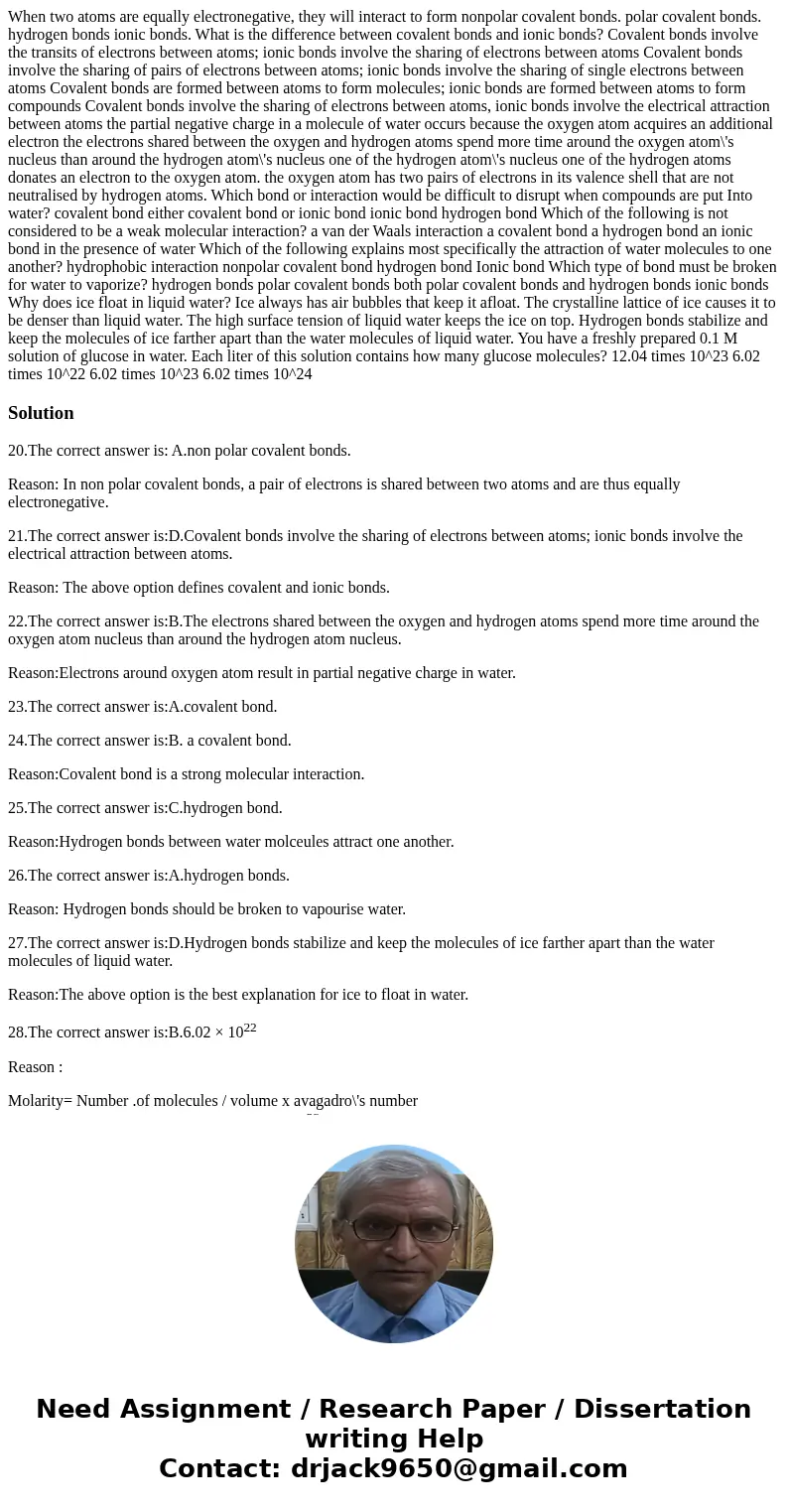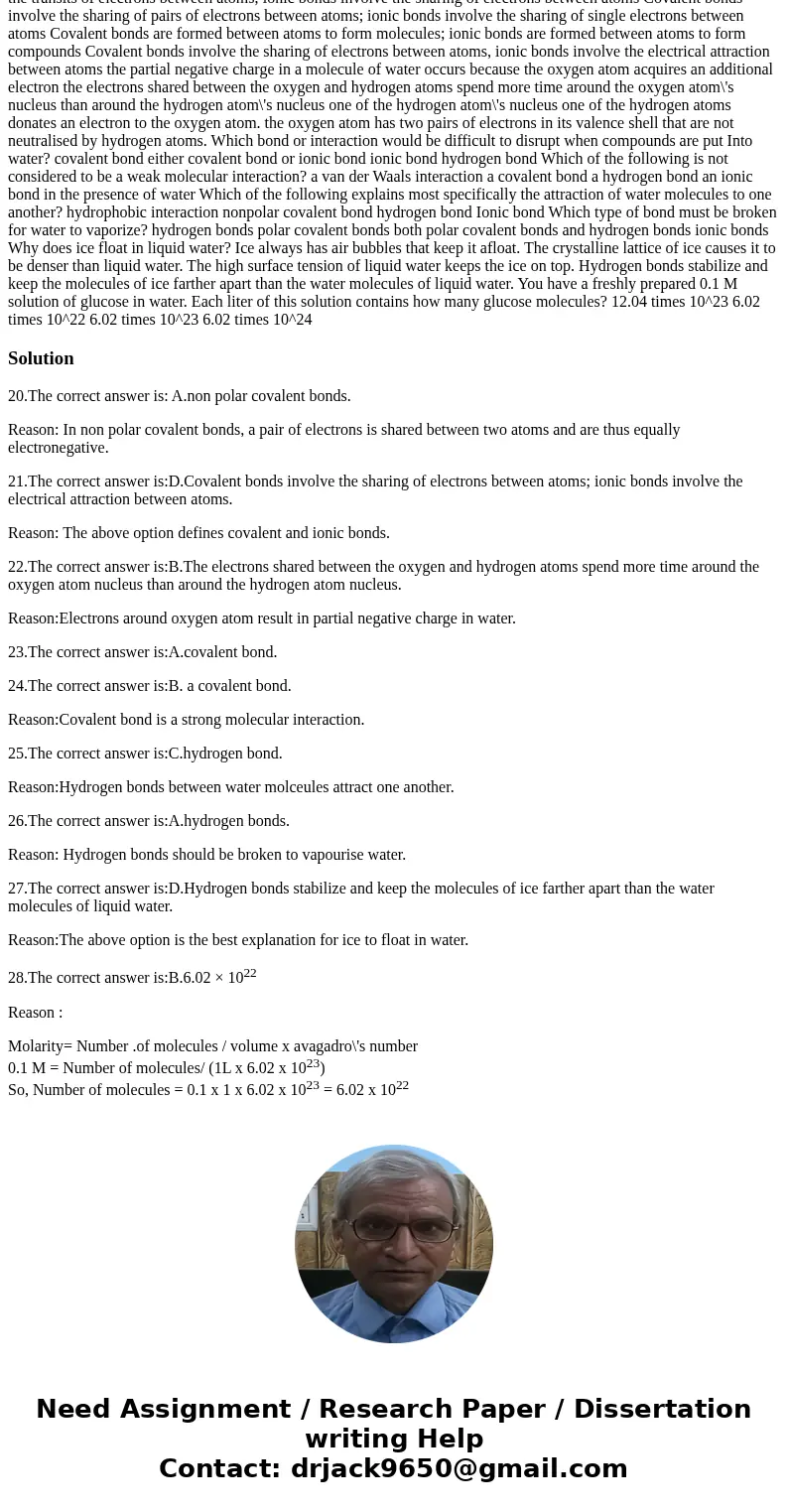When two atoms are equally electronegative, they will interact to form nonpolar covalent bonds. polar covalent bonds. hydrogen bonds ionic bonds. What is the difference between covalent bonds and ionic bonds? Covalent bonds involve the transits of electrons between atoms; ionic bonds involve the sharing of electrons between atoms Covalent bonds involve the sharing of pairs of electrons between atoms; ionic bonds involve the sharing of single electrons between atoms Covalent bonds are formed between atoms to form molecules; ionic bonds are formed between atoms to form compounds Covalent bonds involve the sharing of electrons between atoms, ionic bonds involve the electrical attraction between atoms the partial negative charge in a molecule of water occurs because the oxygen atom acquires an additional electron the electrons shared between the oxygen and hydrogen atoms spend more time around the oxygen atom\'s nucleus than around the hydrogen atom\'s nucleus one of the hydrogen atom\'s nucleus one of the hydrogen atoms donates an electron to the oxygen atom. the oxygen atom has two pairs of electrons in its valence shell that are not neutralised by hydrogen atoms. Which bond or interaction would be difficult to disrupt when compounds are put Into water? covalent bond either covalent bond or ionic bond ionic bond hydrogen bond Which of the following is not considered to be a weak molecular interaction? a van der Waals interaction a covalent bond a hydrogen bond an ionic bond in the presence of water Which of the following explains most specifically the attraction of water molecules to one another? hydrophobic interaction nonpolar covalent bond hydrogen bond Ionic bond Which type of bond must be broken for water to vaporize? hydrogen bonds polar covalent bonds both polar covalent bonds and hydrogen bonds ionic bonds Why does ice float in liquid water? Ice always has air bubbles that keep it afloat. The crystalline lattice of ice causes it to be denser than liquid water. The high surface tension of liquid water keeps the ice on top. Hydrogen bonds stabilize and keep the molecules of ice farther apart than the water molecules of liquid water. You have a freshly prepared 0.1 M solution of glucose in water. Each liter of this solution contains how many glucose molecules? 12.04 times 10^23 6.02 times 10^22 6.02 times 10^23 6.02 times 10^24
20.The correct answer is: A.non polar covalent bonds.
Reason: In non polar covalent bonds, a pair of electrons is shared between two atoms and are thus equally electronegative.
21.The correct answer is:D.Covalent bonds involve the sharing of electrons between atoms; ionic bonds involve the electrical attraction between atoms.
Reason: The above option defines covalent and ionic bonds.
22.The correct answer is:B.The electrons shared between the oxygen and hydrogen atoms spend more time around the oxygen atom nucleus than around the hydrogen atom nucleus.
Reason:Electrons around oxygen atom result in partial negative charge in water.
23.The correct answer is:A.covalent bond.
24.The correct answer is:B. a covalent bond.
Reason:Covalent bond is a strong molecular interaction.
25.The correct answer is:C.hydrogen bond.
Reason:Hydrogen bonds between water molceules attract one another.
26.The correct answer is:A.hydrogen bonds.
Reason: Hydrogen bonds should be broken to vapourise water.
27.The correct answer is:D.Hydrogen bonds stabilize and keep the molecules of ice farther apart than the water molecules of liquid water.
Reason:The above option is the best explanation for ice to float in water.
28.The correct answer is:B.6.02 × 1022
Reason :
Molarity= Number .of molecules / volume x avagadro\'s number
0.1 M = Number of molecules/ (1L x 6.02 x 1023)
So, Number of molecules = 0.1 x 1 x 6.02 x 1023 = 6.02 x 1022


 Homework Sourse
Homework Sourse